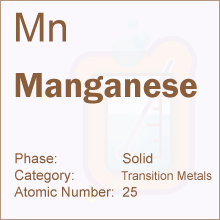 Periodic Table -> Manganese
Periodic Table -> ManganeseManganese
Manganese DetailsManganese Symbol: Mn
Manganese Atomic Number: 25
Manganese Atomic Weight: 54.938
What is Manganese?
Manganese (atomic number 25, symbol Mn) is a chemical element found in many minerals and as a free element in nature. It is a silvery-gray in color and resembles iron. Manganese is difficult to fuse and very brittle, but it is easy to oxidize. The ions of manganese and the metal itself are paramagnetic.
The element is named for different minerals found in the Greek region Magnesia. In the 18th century, Carl Wilhelm Scheele, a Swedish chemist, used one of them, pyrolusite to produce chlorine. He was aware that this mineral contained an unknown element but was unable to isolate it. In 1774, Johan Gottlieb Gahn reduced manganese dioxide with carbon and isolated an impure manganese sample.
Scientists have characterized 18 radioisotopes of magnesium, and magnesium-55, magnesium-53, and magnesium-54 are the most stable of them. The half-life of magnesium-55 is 3.7 million years. The half-life of its other radioisotopes is less than 3 hours. Magnesium also has 3 meta states (nuclear isomers).
This element is essential to steel and iron production. Steel production accounts for 85 percent to 90 percent of the total demand. In addition, manganese is a major element of some widely used alloys of aluminum and is employed in stainless steel formulation. Manganese is also used to produce violet colored class and to decolorize glass, with manganese dioxide being used as a catalyst. Potassium permanganate is used as a disinfectant, and it is a powerful oxidizer. Manganese carbonate and manganese oxide also have applications. The latter is used in ceramics and fertilizers, and the former goes into various manganese compounds.

Manganese dioxide or manganese (IV) oxide has application in organic chemistry and is used to oxidize benzylic alcohols. Manganese dioxide is also used to produce chlorine and oxygen, and in drying black paints. In addition, manganese is used to produce coins. The wartime nickel is the only US coin to contain manganese until 2000. Traditionally, an alloy of 25 percent nickel and 75 percent copper was used to produce nickel coins. Due to shortage of nickel, manganese and silver substituted it during the war. The resulting alloy was made of 9 percent manganese, 35 percent silver, and 56 percent copper. Since 2000, Presidential $1 coins, the Sacagawea dollar, and other dollar coins have been produced from brass and contain 5 percent manganese. The use of the alloy aims to duplicate the properties of the nickel/ copper alloy.
Manganese is among the most abundant metals found in soils, occurring in the form of hydroxides and oxides. The element occurs as rhodochrosite and pyrolusite. The estimated reserves of manganese are over 3 billion tonnes, and the major mining sites are in Australia, Ukraine, Gabon, Georgia, Russia, and South Africa. Other mining sites are found in Mexico, Kazakhstan, and Ghana.
This element is vital for all species. Sponges, mollusks, diatoms, and other organisms accumulate manganese. Mammals have up to 3 ppm and fish up to 5 ppm in their tissues. The side effects of manganese poisoning occur mostly in the brain and the respiratory tract. Symptoms include nerve damage, forgetfulness, and hallucinations. Manganese poisoning can cause bronchitis, lung embolism, Parkinson, and impotency. A syndrome caused by the element has symptoms like headaches, weak muscles, dullness, insomnia, and schizophrenia. Shortages of manganese cause glucose intolerance, skeleton disorders, skin problems, and birth defects.
You can
link to this page, using the code below:
Periodic Table |
Banks
© ElementsDatabase.com 2015 | Privacy | About | Contact